Field Trials for the Characterization of Non-Intentional Emissions at Low-Voltage Grid in the Frequency Range Assigned to NB-PLC Technologies
Abstract
:1. Introduction
2. Narrowband Power Line Communications (NB-PLC) and Non-Intentional Emissions (NIE)
3. Objectives
4. Methodology
4.1. Measurement Methodology and Data Processing
- A voltage probe that connects the measurement system to the grid, provides galvanic isolation and protects the system against high level transitions.
- A high-resolution oscilloscope (Picoscope series 5000) that samples the noise and NIE levels with high accuracy (16 bits resolution in magnitude) and high sampling frequency (8.92 MHz).
- A laptop to configure the oscilloscope, automatize the measurements, and record the signals registered by the oscilloscope.
4.2. Types of Results
- Spectrograms showing the evolution in time of the power spectral density (PSD) values of NIE were calculated and represented in a color scale, all of them for a frequency range of 20–500 kHz and a time period of 5 s. The spectrograms allow the characterization of both spectral and time behavior of NIE at each measurement point.
- The quasi-peak amplitude of NIE, according to the CISPR 16 assessment methodology (see Section 4.1), provides a clear representation of the spectral shape and the relevance of different types of NIE. In order to avoid NB-PLC signals in the data processing, the quasi-peak amplitude of NIE is calculated for a time interval of 0.5 s (the time interval selected for this type of graph is indicated in the corresponding spectrogram by means of two black lines, as shown in Figure 3).
- In order to compare the level of NIE for different scenarios and situations, the datasets are classified and compiled by groups. For each group, the values are statistically evaluated by means of a representative set of percentiles: 0th (minimum), 10th, 50th (median), 90th and 100th (maximum), and then, the results of different groups are compared in Section 6.4.
- The combined analysis of spectrograms and the CISPR 16 graphs allows the identification and characterization of different types of NIE, both in time and frequency domains. An ad hoc software developed by the authors provides all the aforementioned types of results.
4.3. Analysis of Results
- First, emissions have been classified according to their spectral components.
- Second, emissions have been analyzed as a function of the frequency range where they occur (below or above 150 kHz).
- Third, the time variability of the recorded NIE is evaluated, by means of the spectrograms of the signals registered in all the measurement points, since this type of graphs shows in detail the time-variability of the amplitude for the whole frequency range.
- Finally, NIE are classified as a function of the scenario where they have been recorded.
5. Planning of the Empirical Trials
5.1. Measurement Scenarios
5.2. Measurement Campaign
6. Results and Analysis
6.1. Types of NIE Registered in the Field Trials
6.1.1. Tonal Emissions
6.1.2. Harmonics of Tonal Emissions
6.1.3. Wide Band NIE
6.1.4. NIE in the Form of Colored Noise
6.1.5. Replicas of NB-PLC Transmissions
6.1.6. Combination of Different Types of Noise
6.2. NIE in Function of the Frequency Range
6.2.1. Low Part of the Frequency Range (Below 150 kHz)
6.2.2. Upper Part of the Frequency Range (above 150 kHz)
6.3. Variation with Time
6.4. Comparison of Levels of NIE for Different Scenarios
6.4.1. Rural vs. Urban Scenarios
6.4.2. NIE at Transformer Substations
7. Conclusions
Author Contributions
Funding
Acknowledgments
Conflicts of Interest
References
- Rönnberg, S.K.; Bollen, M.H.J.; Amaris, H.; Chang, G.W.; Gu, I.Y.H.; Kocewiak, Ł.H.; Meyer, J.; Olofsson, M.; Ribeiro, P.F.; Desmet, J. On waveform distortion in the frequency range of 2 kHz–150 kHz—Review and research challenges. Electr. Power Syst. Res. 2017, 150, 1–10. [Google Scholar] [CrossRef]
- Bartak, G.F.; Abart, A. EMI of Emissions in the Frequency Range 2 kHz—150 kHz. In Proceedings of the CIRED 22nd International Conference on Electricity Distribution, Stockholm, Sweden, 10–13 June 2013. [Google Scholar]
- Uribe-Pérez, N.; Angulo, I.; Hernández, L.; Arzuaga, T.; de la Vega, D.; Arrinda, A. Study of Unwanted Emissions in the CENELEC-A Band Generated by Distributed Energy Resources and Their Influence over Narrow Band Power Line Communications. Energies 2016, 9, 1007. [Google Scholar] [CrossRef]
- Fernandez, I.; Uribe-Pérez, N.; Eizmendi, I.; Angulo, I.; de la Vega, D.; Arrinda, A.; Arzuaga, T. Characterization of non-intentional emissions from distributed energy resources up to 500 kHz: A case study in Spain. Int. J. Electr. Power Energy Syst. 2019, 105, 549–563. [Google Scholar] [CrossRef]
- European Comission. Electromagnetic Compatibility (EMC) Directive. 2014. Available online: http://ec.europa.eu/growth/sectors/electrical-engineering/emc-directive_en (accessed on 4 September 2019).
- Meyer, J.; Haehle, S.; Schegner, P. Impact of higher frequency emission above 2 kHz on electronic mass-market equipment. In Proceedings of the 22nd International Conference and Exhibition on Electricity Distribution (CIRED 2013), Stockholm, Sweden, 10–13 June 2013. [Google Scholar]
- CENELEC. CLC/TR 50627. Study report on electromagnetic interference between electrical equipment/systems in the frequency range below 150 kHz. In CENELEC SC 205A Mains Communicating Systems; CENELEC: Brussels, Belgium, 2015. [Google Scholar]
- CENELEC. EN 55016-1-2. Specification for Radio Disturbance and Immunity Measuring Apparatus and Methods—Part 1–2: Radio Disturbance and Immunity Measuring Apparatus—Coupling Devices for Conducted Disturbance Measurements; CENELEC: Brussels, Belgium, 2014. [Google Scholar]
- Standardization in the Field of Electromagnetic Compatibility with Regard to Low Frequency Phenomena, IEC SC 77A. Available online: https://www.iec.ch/dyn/www/f?p=103:7:16479330001452 (accessed on 4 September 2019).
- IEEE EMC. On the Aim and Scope of TC 7—Document for the TC 7. In Proceedings of the Inaugural Annual Meeting, Santa Ana Pueblo, NM, USA, 13–15 August 2012. IEEE EMC Society Agenda Report. [Google Scholar]
- IEEE Guide for Identifying and Improving Power Quality in Power Systems. IEEE 1250–2018. Available online: https://standards.ieee.org/content/ieee-standards/en/standard/1250-2018.html (accessed on 4 September 2019).
- JWG C4.24/CIRED. Power Quality and EMC Issues with Future Electricity Networks. CIGRE Technical Brochure 719. 2018. Available online: www.e-cigre.org (accessed on 4 September 2019).
- IEC. Establishment of a Joint Working Group between CISPR SC/H and IEC SC77A on the Introduction of Requirements in the Frequency range 9–150 kHz; TC77A/987/INF; IEC: Geneva, Switzerland, 2017; Available online: https://www.iec.ch/dyn/www/f?p=103:52:0::::FSP_ORG_ID,FSP_DOC_ID,FSP_DOC_PIECE_ID:1384,1009394,317392 (accessed on 4 September 2019).
- IEC. Electromagnetic Compatibility (EMC)—Part 4-30: Testing and Measurement Techniques—Power Quality Measurement Methods, 3rd ed.; IEC 61000-4-30; IEC: Geneva, Switzerland, 2015. [Google Scholar]
- CENELEC SC 205A. CLC/TR 50669. Investigation Results on Electromagnetic Interference in the Frequency Range Below 150 kHz; CENELEC: Brussels, Belgium, 2017. [Google Scholar]
- Bollen, M.H.J.; Olofsson, M.; Larsson, E.O.A.; Rönnberg, S.K.; Lundmark, M. Standards for supraharmonics (2 to 150 kHz). IEEE Electromagn. Compat. Mag. 2014, 3, 114–119. [Google Scholar] [CrossRef]
- JWG C4/C6.29. Power Quality Aspects of Solar Power. CIGRE Technical Brochure 672. 2016. Available online: www.e-cigre.org (accessed on 4 September 2019).
- Lampe, L.; Tonello, A.M.; Swart, T.G. Power Line Communications: Principles, Standards and Applications from Multimedia to Smart Grid, 2nd ed.; Wiley: Chichester, UK, 2016. [Google Scholar]
- Laverty, D.M.; Morrow, D.J.; Best, R.; Crossley, P.A. Telecommunications for smart grid: Backhaul solutions for the distribution network. In Proceedings of the IEEE Power and Energy Society General Meeting, Providence, RI, USA, 25–29 July 2010. [Google Scholar]
- Galli, S.; Lys, T. Next generation Narrowband (under 500 kHz) Power Line Communications (PLC) standards. China Commun. 2015, 12, 1–8. [Google Scholar] [CrossRef]
- Andreadou, N.; Guardiola, M.O.; Fulli, G. Telecommunication Technologies for Smart Grid Projects with Focus on Smart Metering Applications. Energies 2016, 9, 375. [Google Scholar] [CrossRef]
- Oksman, V.; Zhang, J.G. HNEM: The new ITU-T standard on narrowband PLC technology. IEEE Commun. Mag. 2011, 49, 36–44. [Google Scholar] [CrossRef]
- Meters and More—Open Technologies. Available online: http://www.metersandmore.com/ (accessed on 4 September 2019).
- The G3-PLC Alliance. Available online: http://www.g3-plc.com/ (accessed on 4 September 2019).
- ITU-T Rec. G.9903. Narrowband Orthogonal Frequency Division Multiplexing Power Line Communication Transceivers for G3-PLC Networks. February 2014. Available online: http://www.itu.int/rec/T-REC-G.9903 (accessed on 4 September 2019).
- IEEE Standard 1901.2–2013. Standard for Low Frequency (Less Than 500 kHz) Narrow Band Power Line Communications for Smart Grid Applications; IEEE Standard: New York, NY, USA, 2013. [Google Scholar]
- PRIME Alliance. Advanced Meter Reading & Smart Grid Standard. Available online: http://www.prime-alliance.org/ (accessed on 4 September 2019).
- PRIME Alliance Technical Working Group. Draft Specification for PoweRline Intelligent Metering Evolution. Available online: http://www.prime-alliance.org/wp-content/uploads/2013/04/PRIME-Spec_v1.3.6.pdf (accessed on 4 September 2019).
- PRIME Alliance Technical Working Group. Specification for PoweRline Intelligent Metering Evolution. Available online: http://www.prime-alliance.org/wp-content/uploads/2014/10/PRIME-Spec_v1.4-20141031.pdf (accessed on 4 September 2019).
- PRIME Alliance Technical Working Group. PRIME 1.4 White Paper. Available online: http://www.prime-alliance.org/wp-content/uploads/2014/10/whitePaperPrimeV1p4_final.pdf (accessed on 4 September 2019).
- Narrowband Orthogonal Frequency Division Multiplexing Power Line Communication Transceivers for PRIME Networks. ITU-T Rec. G.9904. October 2012. Available online: http://www.itu.int/rec/T-REC-G.9904 (accessed on 4 September 2019).
- Schottke, S.; Meyer, J.; Schegner, P.; Bachmann, S. Emission in the frequency range of 2 kHz to 150 kHz caused by electrical vehicle charging. In Proceedings of the International Symposium on Electromagnetic Compatibility (EMC Europe), Gothenburg, Sweden, 1–4 September 2014; pp. 620–625. [Google Scholar]
- CENELEC EN 55015:2013 Limits and Methods of Measurement of Radio Disturbance Characteristics of Electrical Lighting and Similar Equipment; CENELEC: Brussels, Belgium, 2013.
- Rönnberg, S.K.; Bollen, M.H.J.; Gil-de-Castro, A. Harmonic Distortion from Energy-Efficient Equipment and Production in the Low-Voltage Network; Final Report Swedish Energy Administration Project 31681-2; Swedish Energy Administration: Luleå, Sweden, 2014. [Google Scholar]
- Roggo, D.; Horta, R.; Capponi, L.; Eggenschwiler, L.; Decorvet, F.; Pellodi, C.; Buholzer, F. Electromagnetic interferences in smart grid applications: A case study with power line communication smart meters and PV energy generation. Cired Open Access Proc. J. 2017, 2017, 607–611. [Google Scholar] [CrossRef]
- Sendin, A.; Berganza, I.; Arzuaga, A.; Pulkkinen, A.; Kim, I.H. Performance results from 100,000+ PRIME smart meters deployment in Spain. In Proceedings of the 2012 IEEE Third International Conference on Smart Grid Communications (SmartGridComm), Tainan, Taiwan, 5–8 November 2012; pp. 145–150. [Google Scholar]
- Meyer, J.; Mueller, S.; Ungethuem, S.; Xiao, X.; Collin, A.; Djokic, S. Harmonic and supraharmonic emission of on-board electric vehicle chargers. In Proceedings of the 2016 IEEE PES Transmission & Distribution Conference and Exposition-Latin America (PES T&D-LA), Morelia, Mexico, 20–24 September 2016; pp. 1–7. [Google Scholar]
- IEC TS 62578:2015. Power Electronics Systems and Equipment. Operation Conditions and Characteristics of Active Infeed Converter (AIC) Applications Including Design Recommendations for Their Emission Values below 150 kHz; IEC: Geneva, Switzerland, 2015. [Google Scholar]
- Meyer, J.; Bollen, M.; Amaris, H.; Blanco, A.M.; de Castro, A.G.; Desmet, J.; Kocewiak, L.; Rönnberg, S.K.; Yang, K. Future work on harmonics—Some expert opinions Part II—Supraharmonics, standards and measurements. In Proceedings of the 2014 16th International Conference on Harmonics and Quality of Power (ICHQP), Bucharest, Romania, 25–28 May 2014; pp. 909–913. [Google Scholar]
- Klatt, M.; Meyer, J.; Schegner, P. Comparison of measurement methods for the frequency range of 2 kHz to 150 kHz. In Proceedings of the 2014 16th International Conference on Harmonics and Quality of Power (ICHQP), Bucharest, Romania, 25–28 May 2014; pp. 818–822. [Google Scholar]
- Grevener, A.; Meyer, J.; Rönnberg, S.K. Comparison of Measurement Methods for the Frequency Range 2–150 kHz (Supraharmonics). In Proceedings of the 2018 IEEE 9th International Workshop on Applied Measurements for Power Systems (AMPS), Bologna, Italy, 26–28 September 2018; pp. 1–6. [Google Scholar]
- Grid Measurements of 2–150 kHz harmonics to support normative emission limits for mass-market electrical goods. European Metrology project 18NRM05 SupraEMI, EMPIR Call 2018. Available online: http://empir.npl.co.uk/supraemi/ (accessed on 4 September 2019).
- Fernández, I.; Arrinda, A.; Angulo, I.; Alberro, M.; Montalbán, J.; de la Vega, D. Measurement method for the characterization of NIE of LV networks for the frequency range for NB-PLC up to 500 kHz. In Proceedings of the CENELEC SC205A WG11 6th Meeting, Viena, Austria, 2 October 2018. [Google Scholar]
- IEC. CISPR16-1-1- Specification for Radio Disturbance and Immunity Measuring Apparatus and Methods—Part 1-1: Radio Disturbance and Immunity Measuring Apparatus—Measuring Apparatus; IEC: Geneva, Switzerland, 2010. [Google Scholar]
- IEC. CISPR16-2-1:2014. CISPR 16-2-1:2014. Specification for Radio Disturbance and Immunity Measuring Apparatus and Methods—Part 2-1: Methods of Measurement of Disturbances and Immunity—Conducted Disturbance Measurements; IEC: Geneva, Switzerland, 2014. [Google Scholar]
- IEC. CISPR16-2-2:2010. Specification for Radio Disturbance and Immunity Measuring Apparatus and Methods—Part 2-2: Methods of Measurement of Disturbances and Immunity—Measurement of Disturbance Power; IEC: Geneva, Switzerland, 2010. [Google Scholar]
- Proakis, J.G.; Manolakis, D.K. Digital Signal Processing, 4th ed.; Pearson: London, UK, 2007. [Google Scholar]
- Fernandez, I.; Arrinda, A.; Angulo, I.; de la Vega, D.; Uribe, N.; Llano, A. Field trials for the Empirical Characterization of the Low Voltage Grid Access Impedance from 35 kHz to 500 kHz. IEEE Access 2019, 7, 85786–85795. [Google Scholar] [CrossRef]
- Rönnberg, S.K.; de Castro, A.G.; Delgado, A.E. Variations in supraharmonic levels in low voltage networks. In Proceedings of the 25th International Conference on Electricity Distribution CIRED, Madrid, Spain, 3–6 June 2019. [Google Scholar]
- Rönnberg, S.K.; Gil-De-Castro, A.; Medina-Gracia, R. Supraharmonics in European and North American Low-Voltage Networks. In Proceedings of the 2018 IEEE International Conference on Environment and Electrical Engineering and 2018 IEEE Industrial and Commercial Power Systems Europe (EEEIC/I&CPS Europe), Palermo, Italy, 12–15 June 2018; pp. 1–6. [Google Scholar]
- Klatt, M.; Meyer, J.; Schegner, P.; Koch, A.; Myrzik, J.; Körner, C.; Darda, T.; Eberl, G. Emission Levels above 2kHz—Laboratory Results and Survey Measurements in Public Low Voltage Grids. In Proceedings of the 22nd International Conference on Electricity Distribution, CIRED, Stockholm, Sweden, 10–13 June 2013. [Google Scholar]
- Varatharajan, A.; Schoettke, S.; Meyer, J.; Abart, A. Harmonic emission of large PV installations—case study of a 1 MW solar campus. In Proceedings of the ICREPQ International Conference on Renewable Energies and Power Quality, Cordoba, Spain, 7–10 April 2014. [Google Scholar]
- Larsson, E.O.A.; Bollen, M.H.J.; Wahlberg, M.G.; Lundmark, C.M.; Ronnberg, S.K. Measurements of High-Frequency (2–150 kHz) Distortion in Low-Voltage Networks. IEEE Trans. Power Deliv. 2010, 25, 1749–1757. [Google Scholar] [CrossRef]
- Larsson, E.O.A. High Frequency Distortion in Power Grids Due to Electronic Equipment. Licentiate Dissertation, Luleå University Technology, Skellefteå, Sweden, 2006. [Google Scholar]
- Gil-de-Castro, A.; Moreno-Munoz, A.; Larsson, A.; de la Rosa, J.G.; Bollen MH, J. LED Street Lighting: A Power Quality Comparison among Street Light Technologies. Light. Res. Technol. 2013, 45, 710–728. [Google Scholar] [CrossRef]
- López, G.; Moreno, J.I.; Sánchez, E.; Martínez, C.; Martín, F. Noise Sources, Effects and Countermeasures in Narrowband Power-Line Communications Networks: A Practical Approach. Energies 2017, 10, 1238. [Google Scholar] [CrossRef]
- da Rocha Farias, L.; Monteiro, L.; Leme, M.; Stevan, S. Empirical Analysis of the Communication in Industrial Environment Based on G3-Power Line Communication and Influences from Electrical Grid. Electronics 2018, 7, 194. [Google Scholar] [CrossRef]
- Zhu, Q.; Chen, Z.; He, X. Resource Allocation for Relay-Based OFDMA Power Line Communication System. Electronics 2019, 8, 125. [Google Scholar] [CrossRef]
- Bernacki, K.; Wybrańczyk, D.; Zygmanowski, M.; Latko, A.; Michalak, J.; Rymarski, Z. Disturbance and Signal Filter for Power Line Communication. Electronics 2019, 8, 378. [Google Scholar] [CrossRef]
- Varajão, D.; Araújo, R.E.; Miranda, L.; Lopes, J.P. EMI Filter Design for a Single-stage Bidirectional and Isolated AC–DC Matrix Converter. Electronics 2018, 7, 318. [Google Scholar] [CrossRef]
- Wu, C.; Gao, F.; Dai, H.; Wang, Z. A Topology-Based Approach to Improve Vehicle-Level Electromagnetic Radiation. Electronics 2019, 8, 364. [Google Scholar] [CrossRef]




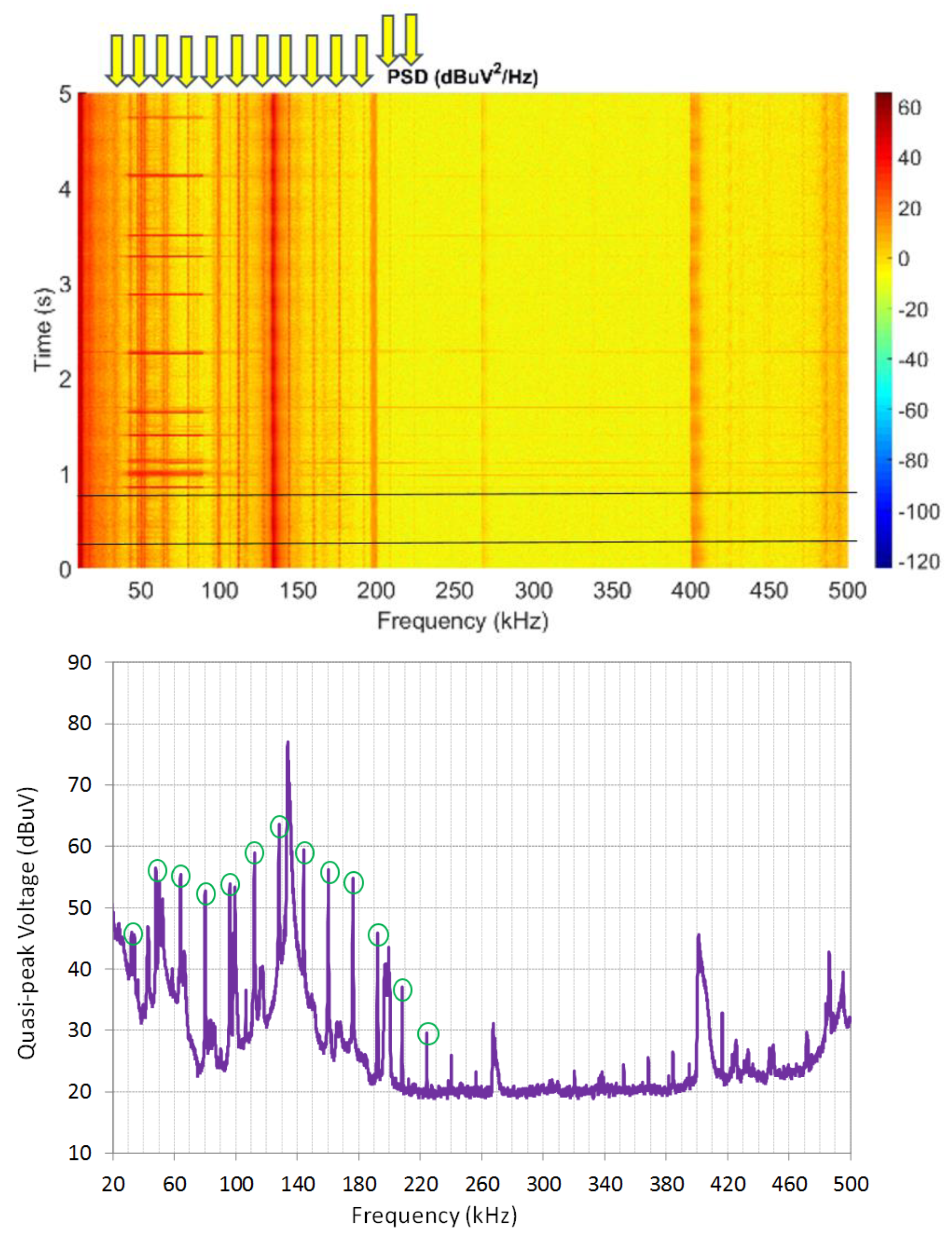






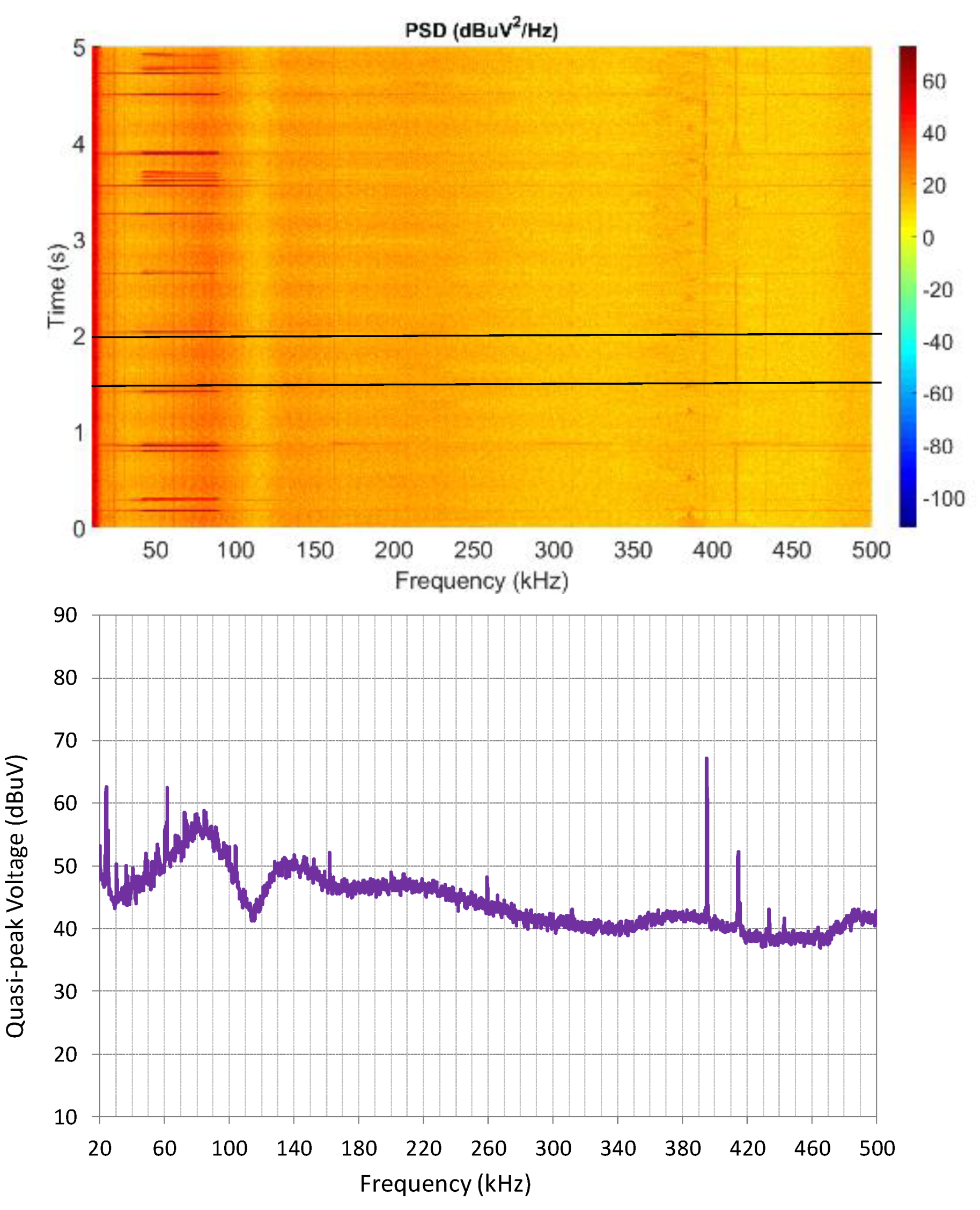

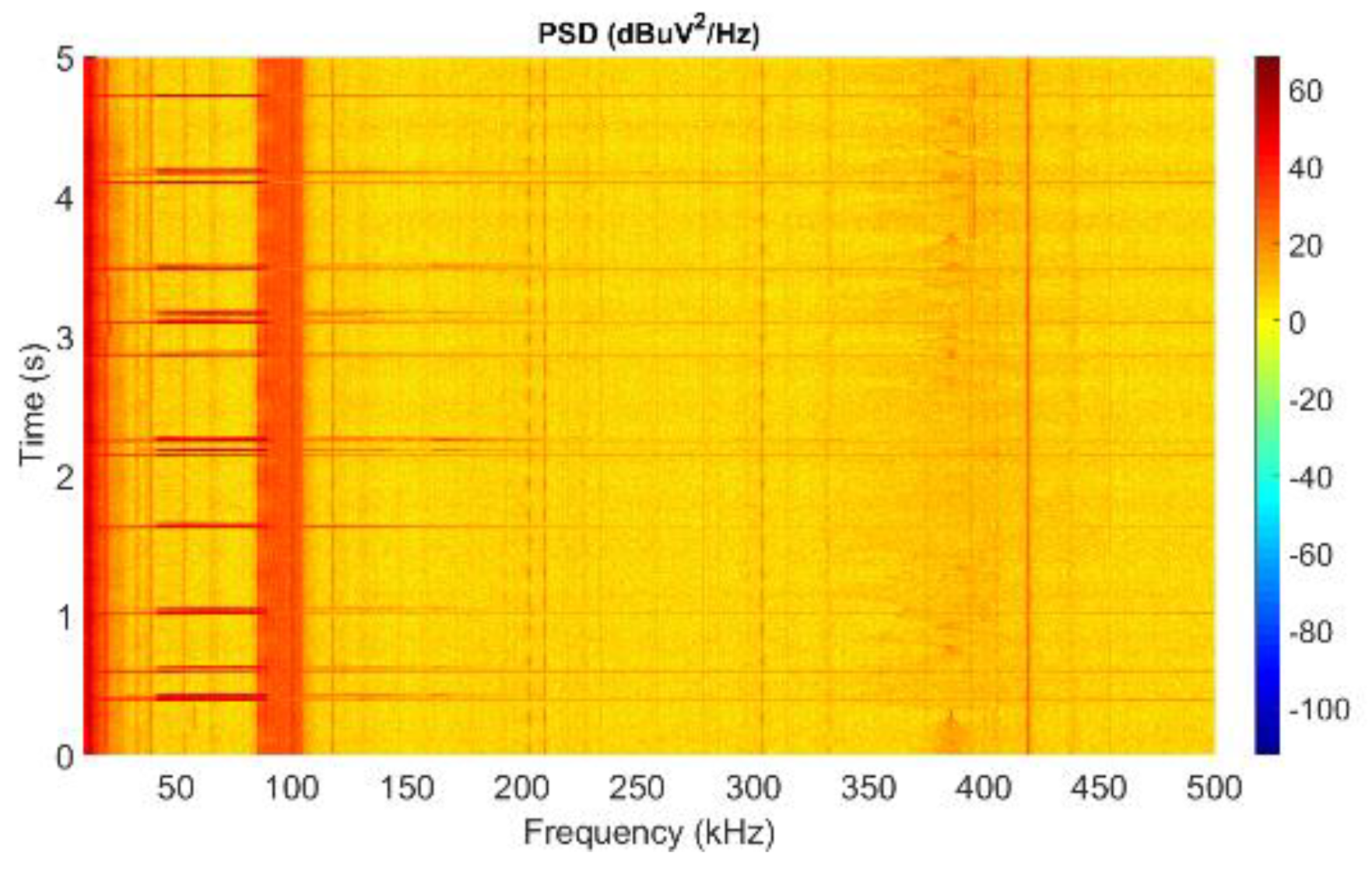
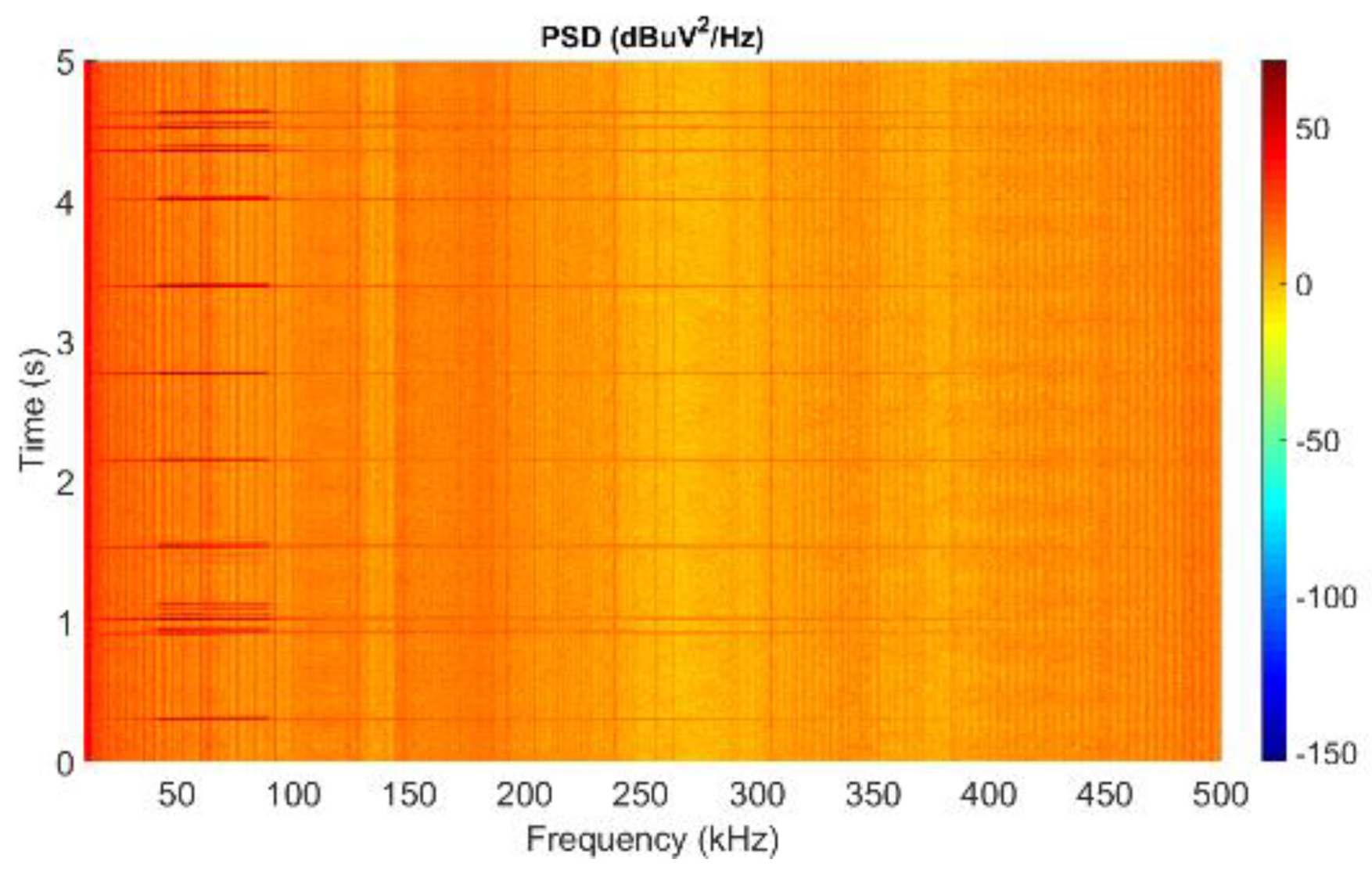

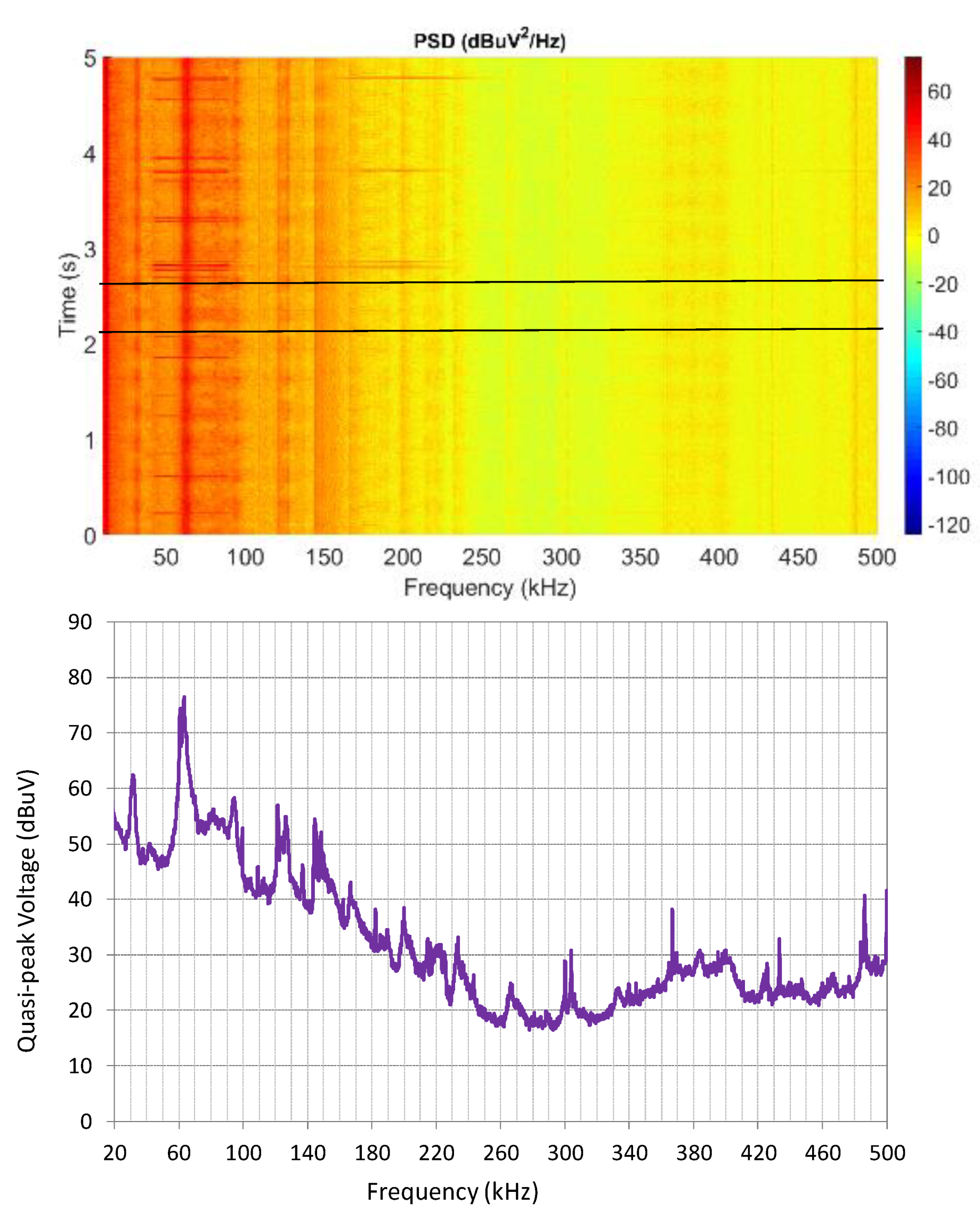

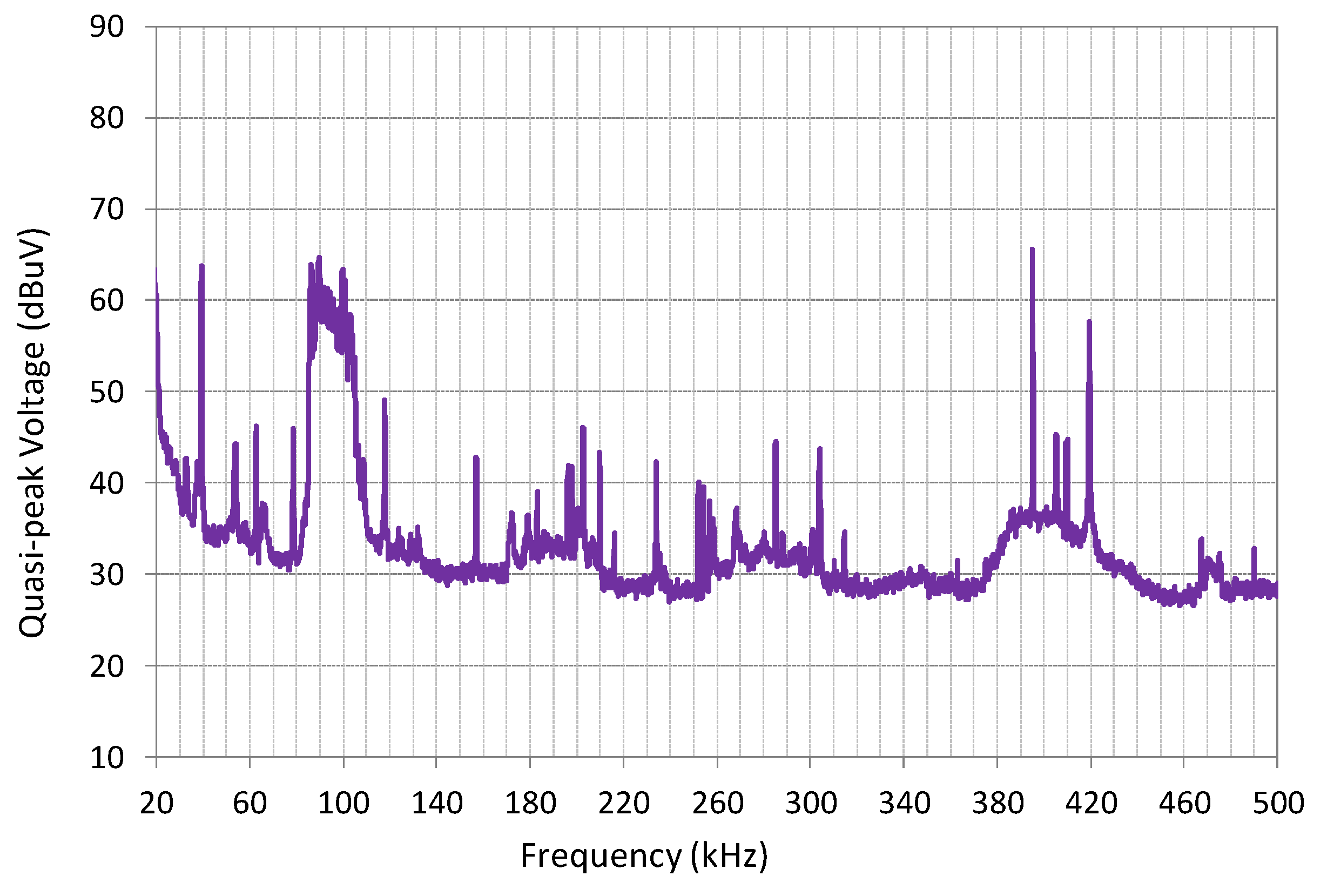


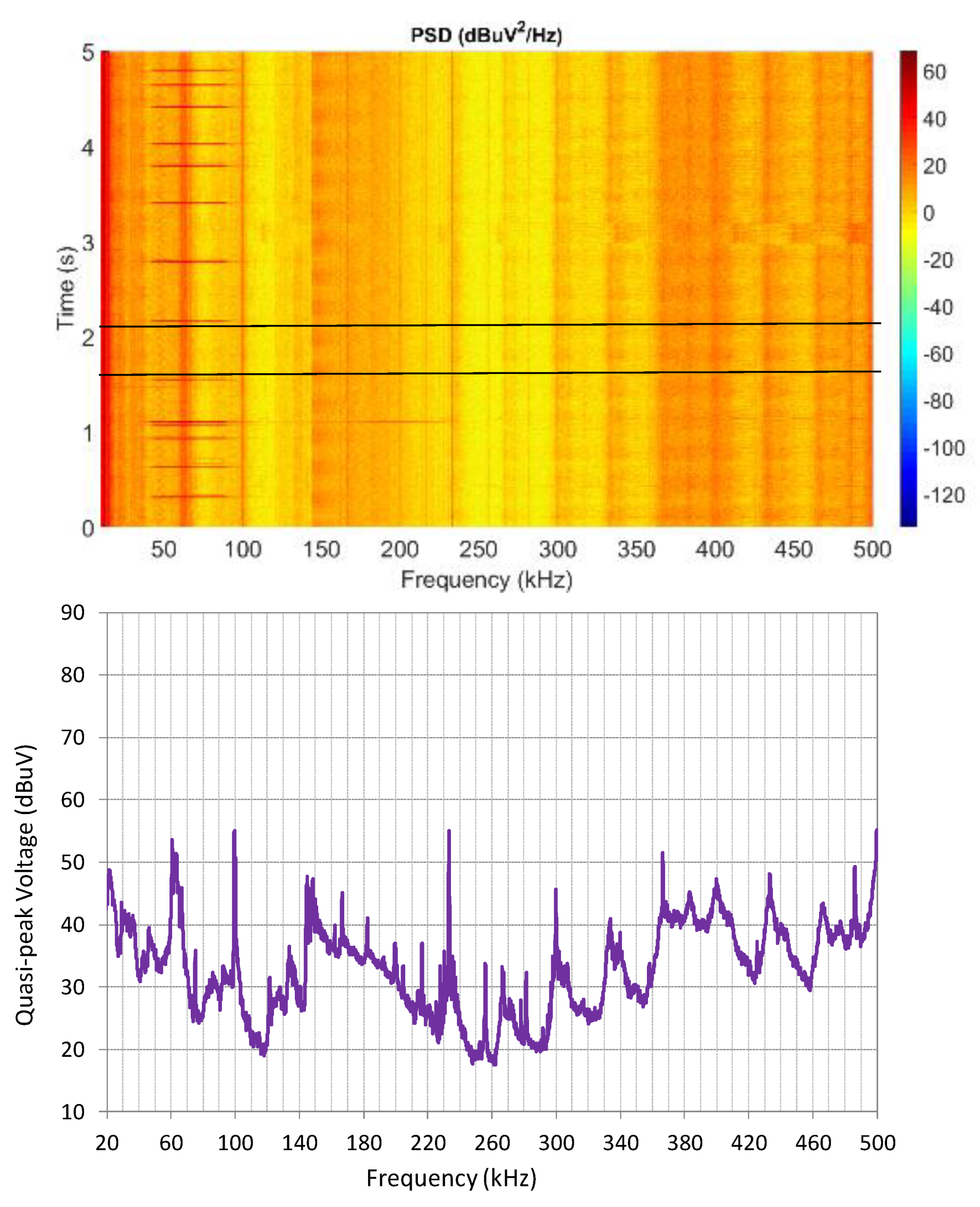





| Number | Scenario | Transformer/Distribution-Grid | Mono-/Tri-Phasic | Number of Measurements Per Phase |
|---|---|---|---|---|
| 1 | Urban-1 | Transformer | Tri-phasic | 3 |
| 2 | Urban-1 | Distribution-grid | Tri-phasic | 1 |
| 3 | Urban-1 | Distribution-grid | Tri-phasic | 1 |
| 4 | Urban-1 | Distribution-grid | Tri-phasic | 1 |
| 5 | Urban-1 | Distribution-grid | Tri-phasic | 1 |
| 6 | Urban-1 | Distribution-grid | Tri-phasic | 1 |
| 7 | Urban-1 | Distribution-grid | Tri-phasic | 1 |
| 8 | Urban-1 | Distribution-grid | Tri-phasic | 1 |
| 9 | Urban-1 | Distribution-grid | Tri-phasic | 1 |
| 10 | Urban-1 | Distribution-grid | Tri-phasic | 1 |
| 11 | Urban-1 | Distribution-grid | Tri-phasic | 1 |
| 12 | Rural-1 | Transformer | Tri-phasic | 1 |
| 13 | Rural-1 | Distribution-grid | Tri-phasic | 1 |
| 14 | Rural-1 | Distribution-grid | Mono-phasic | 1 |
| 15 | Rural-1 | Distribution-grid | Mono-phasic | 1 |
| 16 | Rural-1 | Distribution-grid | Mono-phasic | 1 |
| 17 | Rural-2 | Transformer | Tri-phasic | 1 |
| 18 | Rural-2 | Distribution-grid | Tri-phasic | 1 |
| 19 | Rural-2 | Distribution-grid | Tri-phasic | 1 |
| 20 | Rural-2 | Distribution-grid | Mono-phasic | 1 |
© 2019 by the authors. Licensee MDPI, Basel, Switzerland. This article is an open access article distributed under the terms and conditions of the Creative Commons Attribution (CC BY) license (http://creativecommons.org/licenses/by/4.0/).
Share and Cite
Fernández, I.; de la Vega, D.; Arrinda, A.; Angulo, I.; Uribe-Pérez, N.; Llano, A. Field Trials for the Characterization of Non-Intentional Emissions at Low-Voltage Grid in the Frequency Range Assigned to NB-PLC Technologies. Electronics 2019, 8, 1044. https://doi.org/10.3390/electronics8091044
Fernández I, de la Vega D, Arrinda A, Angulo I, Uribe-Pérez N, Llano A. Field Trials for the Characterization of Non-Intentional Emissions at Low-Voltage Grid in the Frequency Range Assigned to NB-PLC Technologies. Electronics. 2019; 8(9):1044. https://doi.org/10.3390/electronics8091044
Chicago/Turabian StyleFernández, Igor, David de la Vega, Amaia Arrinda, Itziar Angulo, Noelia Uribe-Pérez, and Asier Llano. 2019. "Field Trials for the Characterization of Non-Intentional Emissions at Low-Voltage Grid in the Frequency Range Assigned to NB-PLC Technologies" Electronics 8, no. 9: 1044. https://doi.org/10.3390/electronics8091044
APA StyleFernández, I., de la Vega, D., Arrinda, A., Angulo, I., Uribe-Pérez, N., & Llano, A. (2019). Field Trials for the Characterization of Non-Intentional Emissions at Low-Voltage Grid in the Frequency Range Assigned to NB-PLC Technologies. Electronics, 8(9), 1044. https://doi.org/10.3390/electronics8091044








